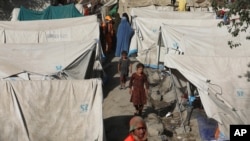The U.N. refugee agency warns millions of Afghans displaced by conflict inside their country are teetering on the brink of a humanitarian catastrophe and need international aid to survive.
An estimated 3.5 million Afghans have been uprooted by conflict and insecurity, including more than half-a-million newly displaced people this year. Women and children account for most of the internally displaced.
The UNHCR has predicted about 500,000 Afghans will likely flee to neighboring countries, attempting to seek asylum. However, U.N. observers at Pakistani and Iranian border points report that a large-scale refugee influx, so far, has not materialized.
Speaking via video link from the Pakistan capital, Islamabad, UNHCR spokesman Babar Baloch said his agency is trying to analyze why so few people are coming.
“There could be many, many reasons but the reality is the displacement crisis is inside Afghanistan.… What we have seen, where the crisis has been, has been an internal displacement crisis and that is why we keep repeating that let us not allow it to become a humanitarian catastrophe, so we are able to support the Afghans inside their country with the support they need,” he said.
Baloch said the border between Pakistan and Afghanistan remains open to commercial trade between the two countries. But he said a limited number of Afghan pedestrians cross every day.
That flow, he said, is very regulated and managed at the border. He said people who have passports, visas or other documents they can show are allowed to enter.
Baloch said an increasing number of Afghans who have arrived in Pakistan have been telling his colleagues their reasons for coming.
“It is insecurity and their intention to seek asylum once they are here. But the movement, the back-and-forth movement is very mixed. A lot of trade going, commercial activities, many people come in terms of trying to seek medical attention on this side,” he said.
Baloch said it is crucial Afghanistan not become a forgotten crisis, adding that the UNHCR is appealing to the world not to turn its attention away from the Afghan people.
He said international support is needed to keep the Afghan people from leaving home. He appealed to the international community not to allow Afghanistan’s internal displacement crisis to become a humanitarian catastrophe.






